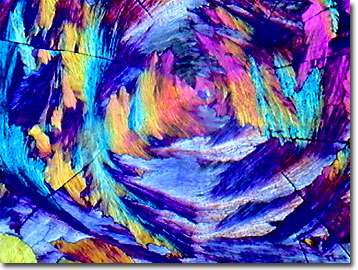Polarized Light Digital Image Gallery
Cholesterol
Despite what some people believe, not all cholesterol is bad and you are not always what you eat, particularly if you are a vegetarian. In fact, cholesterol is essential to life, being a primary component of the membrane that surrounds every cell. It is also the precursor biochemical from which the body synthesizes bile acids, steroid hormones, and vitamin D. Cholesterol circulates in the bloodstream and is manufactured by the liver and several other organs.

Insoluble in the blood, cholesterol must be attached to certain protein complexes, called lipoproteins, in order to be carried through the bloodstream. Low-density lipoproteins (LDLs) transport cholesterol from its site of synthesis in the liver to the various tissues and body cells, where it is separated from the lipoprotein for use by the cell. High-density lipoproteins (HDLs) often transport excess or unused cholesterol from the tissues back to the liver, where it is broken down into bile acids and excreted. Arterosclerotic deposits, which build up in the blood vessels, consist primarily of cholesterol attached to LDLs. HDLs may actually serve to retard or reduce arterosclerotic buildup and people with low high-density lipoprotein levels may actually be at additional health risk.
The formation of the important major steroid hormones from cholesterol occurs through intermediary formation of a steroid known as pregnenolone, which contains the cholesterol nucleus, but has a shorter aliphatic side chain. Pregnenolone is the precursor of progesterone, the female hormone that is dominant during pregnancy, and also androgens (or male sex hormones), such as testosterone. The estrogen female sex hormones, estrone and estradiol, and the adrenal corticosteroids, such as corticosterone, are also metabolic products of cholesterol.
Although vegetarians do not consume dietary cholesterol as would a person dining on a well-marbleized steak or a fatty hamburger, their bodies still contain the vital cholesterol molecules. Slightly over half of the cholesterol in the body of the typical human omnivore is derived from biosynthesis in the liver and intestines. When cells detect that cholesterol is in short supply, acetyl-Coenzyme A from the mitochondria is transported to the cytoplasm to assist in the biosynthesis of more cholesterol. The average, healthy adult synthesizes approximately one gram of cholesterol per day, if about 0.3 grams per day is consumed. Controlling the biosynthetic pathways helps maintain a relatively constant level in the body of about 150 to 200 milligrams per dry liter. The majority of the body's cholesterol is used in bile acid synthesis.
Contributing Authors
Omar Alvarado, Thomas J. Fellers and Michael W. Davidson - National High Magnetic Field Laboratory, 1800 East Paul Dirac Dr., The Florida State University, Tallahassee, Florida, 32310.
BACK TO THE POLARIZED LIGHT IMAGE GALLERY
BACK TO THE DIGITAL IMAGE GALLERIES
Questions or comments? Send us an email.
© 1995-2025 by Michael W. Davidson and The Florida State University. All Rights Reserved. No images, graphics, software, scripts, or applets may be reproduced or used in any manner without permission from the copyright holders. Use of this website means you agree to all of the Legal Terms and Conditions set forth by the owners.
This website is maintained by our
Graphics & Web Programming Team
in collaboration with Optical Microscopy at the
National High Magnetic Field Laboratory.
Last Modification Friday, Nov 13, 2015 at 01:19 PM
Access Count Since September 17, 2002: 18376
Visit the website of our partner in introductory microscopy education:
|
|
